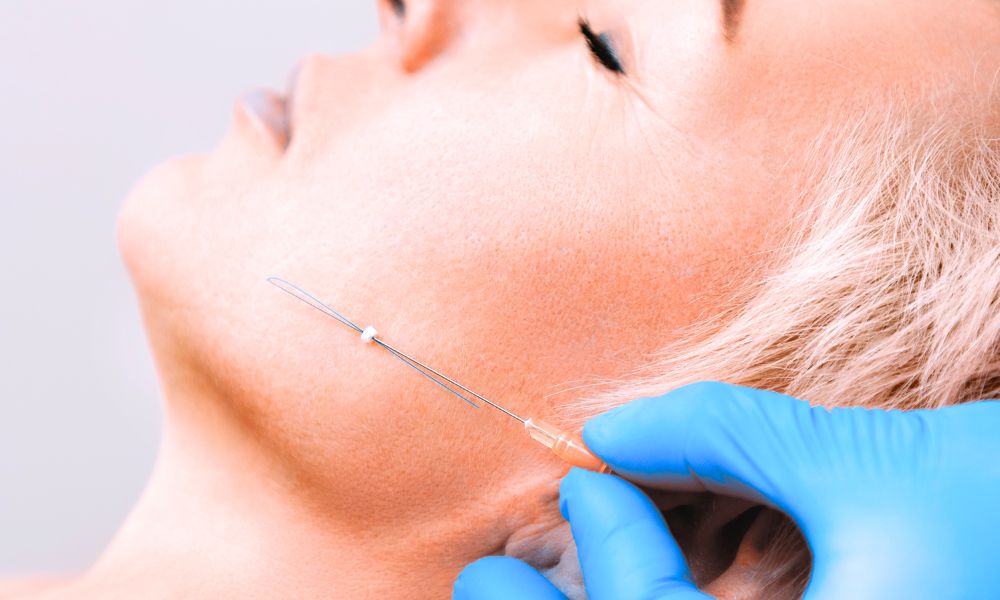At Dermal Health we have an ongoing commitment to providing only the best available aesthetic treatments. Our choice of Definisse Threads for facial contouring and skin revitalisation is an example of this. We chose these as we feel these are the best thread lifts available today. We feel that information surrounding thread lifting is a bit thin on the ground, especially with regard to what they are made from, so this article aims to address that.
Introduction to Definisse Threads
Definisse Threads represent a culmination of a decade of research, aiming to offer an effective solution for non-surgical face lifting and contour enhancement. The brand’s unique element is the use of a blend of poly-L-lactic acid (PLLA) and caprolactone to ensure both an immediate lifting effect and a prolonged revitalising action. This dual approach not only repositions sagging tissues but also stimulates the production of collagen, hyaluronic acid, and elastin, which are vital for maintaining youthful, natural-looking skin.
The efficacy of Definisse threads comes from both the materials used and their design. The barbed nature of the threads allows for secure anchorage once inserted, providing an immediate and visible lifting effect. Their ability to induce fibrosis along the thread length also results in a prolonged, natural lifting impact.
What truly sets Definisse Threads apart, and why Dermal Health has chosen them, is their superior mechanical properties. Compared to other threads in the market, they demonstrate greater elasticity and lower plasticity, translating to more effective and lasting results. Clinical studies support this, showing high levels of patient satisfaction and significant facial improvements.
Poly-L-Lactic Acid: Safety Profile and History in the Body
Safety Profile
PLLA has a commendable safety profile, vital for its use in medical applications. As a biocompatible and biodegradable polymer, PLLA is safely absorbed by the body. The body naturally metabolises its degradation products, lactic acid molecules. The risks, such as localised reactions, are minimal and manageable, particularly under expert administration.
History of Use in the Body
PLLA’s application in medical procedures began in the late 1990s in a dermal filler capacity. Its ability to stimulate collagen production was the aim behind its use for facial rejuvenation. PLLA has since been used in various medical devices, including sutures and orthopaedic implants, valued for its effectiveness in stimulating natural biological processes.
Polycaprolactone (PCL): Safety Profile and History in the Body
Safety Profile
Caprolactone’s excellent safety profile is due to its biocompatibility and gradual degradation into non-toxic substances. This ensures its safety for long-term treatments, with most minor and procedure-related complications.
History of Use in the Body
Polycaprolactone’s use in the medical field spans several decades, initially in drug delivery systems and biodegradable sutures. Its controlled degradation rate and structural integrity have made it useful in regenerative medicine and tissue engineering. In aesthetics, polycaprolactone’s properties are utilised in threads and threads for long-lasting rejuvenation effects.
Definisse Thread for you
The procedure’s minimally invasive nature aligns with our ethos at Dermal Health, offering our clients a comfortable experience with minimal downtime. The safety profile of Definisse Threads is exemplary, with a low risk of complications, which come first in our choice of treatments to offer to our patients.
Definisse Threads aligns perfectly with Dermal Health’s commitment to providing advanced, safe, and effective aesthetic solutions. Their innovative design, proven efficacy, and high safety standards, combined with the beneficial properties of poly-L-lactic acid and polycaprolactone, make them an ideal choice for our clients seeking non-surgical options for facial rejuvenation.

